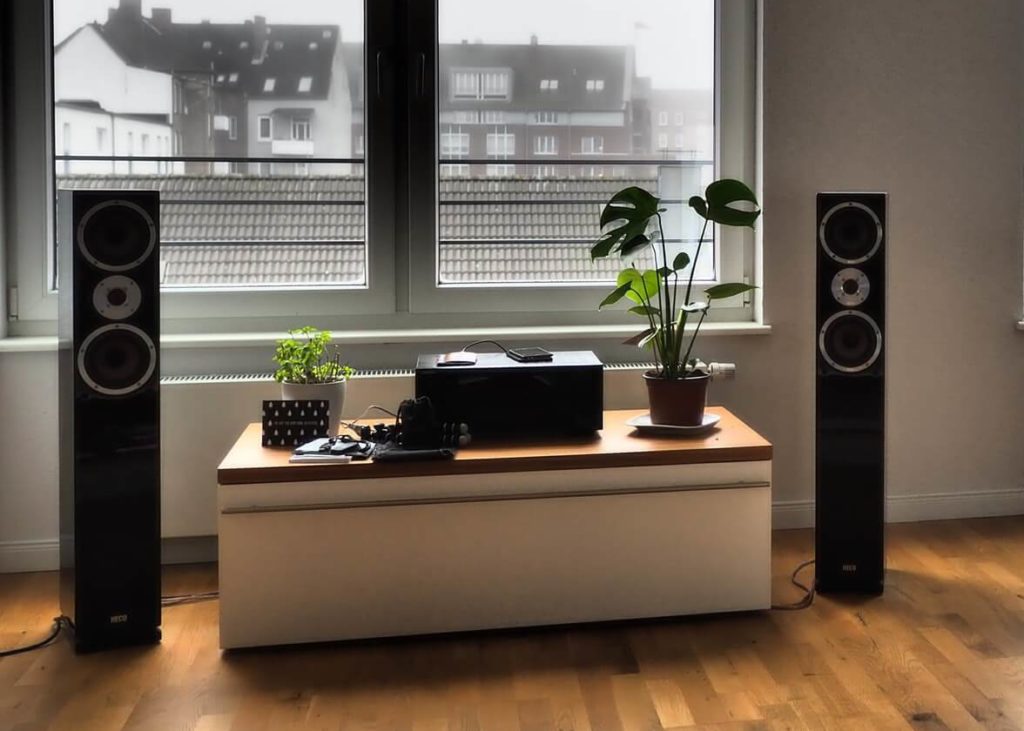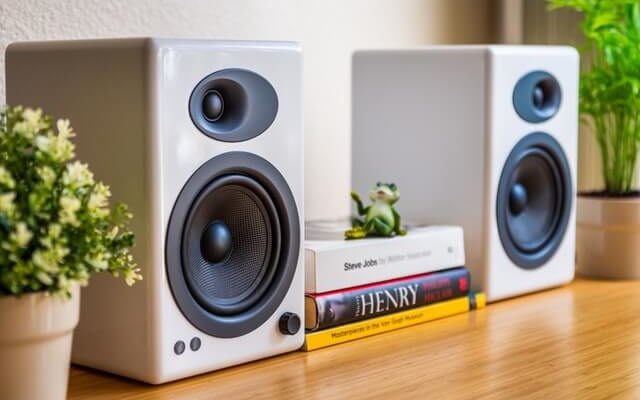If you’re looking to invest in speakers, you have a decision to make: should I buy floorstanding speakers or bookshelf speakers? It’s important to know where they each excel. Read on to find out the difference between floorstanding speakers and bookshelf speakers.
Table of Contents
What Are Floorstanding Speakers?

As their name suggests, floorstanding speakers typically sit on the floor. Also called tower speakers, they normally stand three feet tall or more and span at least seven inches in width. They can be two feet deep or as slim as nine inches, depending on your space. Their larger cabinet size means more space for drivers. More drivers allow them to deliver a wide range of frequencies efficiently. This matters for sound quality, the prime consideration with most floorstanding speakers. Floorstanding speakers are geared toward stereo playback for home theater and music.
What Are Bookshelf Speakers?

In contrast, bookshelf speakers fit on a normal bookshelf. Smaller in size than a tower speaker, most bookshelf speakers typically have just two drivers (a tweeter and a bass driver). Those two drivers do still allow for a relatively wide frequency range. Their smaller size does limit their power though. Some larger bookshelf speakers can be very powerful though. Of course, you can also integrate other elements like a good subwoofer with bookshelf speakers. You will typically need a subwoofer with bookshelf speakers for impactful bass. This will enhance sound quality for bookshelf speakers. Moving them further from the walls will improve audio performance. If floor space is at a premium, bookshelf speakers might be a better fit. With their versatility, bookshelf speakers are good for your home theater and music.
Key Differences: Bookshelf Speakers vs. Floorstanding Speakers
Let’s take a closer look at the difference between bookshelf and floorstanding speakers. It all comes down to three factors: room size (or room modes), budget, and sound.
Bookshelf Speaker Placement Is Easier
Clearly, it’s easier to place bookshelf speakers than floorstanding speakers. A floorstanding speaker will…stand out. But bookshelf speakers can be hidden within your decor. For example, you can build them into cabinets on either side of your home theater system. Bookshelf speakers are often placed on shelves, tables, and other furniture. Mounting them on speaker stands or walls is also possible. They can also be elevated, making it easier to project sound to listeners. The ideal Bookshelf speaker height is where the tweeter is at the listener’s ear level. This can typically be easily achieved with the aforementioned placement options.
Bookshelf speakers really do offer flexibility for placement. Placing bookshelf speakers further out in the room can enhance the audio experience. They can also be shifted around a multi-speaker home theater setup. Their small footprint makes them easy to utilize all-around your listening position.
Floorstanding Speakers Have A Wider Frequency Range
Floorstanding speakers can produce the best sound because of their drivers, especially at lower frequencies. A larger speaker means more drivers. With components dedicated to a specific frequency range, speaker designers can reproduce a wider frequency range. If you want deep bass frequencies, floorstanding speakers can deliver. Pairing with a subwoofer is always optimal. Without a subwoofer, floorstanding speakers will usually out-perform bookshelf speakers for bass.
A larger cabinet on a floorstanding speaker also means more efficiency. Floorstanding speakers can produce a higher sound pressure level (measured in DBs) with less power. This is important for those who want audio to play louder for movies and music. Floorstanding speakers can provide louder volume and a very wide range of frequencies compared to smaller speakers.
Bookshelf Speakers Are Great For Home Theater
Bookshelf speakers can create a compelling home cinema experience. Bookshelf speakers can pack power into a small package. That along with their frequency range allows them to be placed all over your home theater setup. They are often utilized as front speakers and rear surrounds. Some even utilize a single bookshelf speaker as a center channel. Because you can move them around, you have great flexibility. Dolby Atmos without ceiling speakers is possible. Among other substitutes, people have used bookshelf speakers to reproduce Atmos height effects. Their versatile capabilities really make Bookshelf speakers good for home theater systems.
Floorstanding Speakers For Big Bass and Volume
In a home theater environment, with neighbors downstairs or next door, bookshelf speakers may be better. For a larger space, where high volume is needed, the difference between bookshelf speakers and floorstanding speakers becomes clear.
Most floorstanding speakers can produce sound at higher volume with less distortion. They convert power more efficiently into decibels. Because a floorstanding speaker can move more air through the drivers than bookshelf speakers, the bass output is also superior. Deep and impactful bass because more possible.
A pair of floorstanding speakers can reproduce the loudest stereo playback compared to other speakers. You will of course need to power them with a receiver or amplifier. Unlike bookshelf speakers, there aren’t as many options for powered or active floorstanding speakers. Floorstanding speakers are a good bet for high-efficiency speakers to play loud volumes and big bass. Those with a larger listening room may require floorstanding speakers. They are great as front speakers in home theaters or stereo speakers for dedicated listening.
Bookshelf Speakers Are More Affordable
Bookshelf speakers may not have the bass output or high efficiency of floorstanding speakers, but they tend to be more affordable. Great sound quality is also not defined by speaker type. There are bookshelf speakers under $200 with good sound quality. You’ll struggle to find floorstanding speakers under $200 at all. There are also many bookshelf speakers that can outperform floorstanding speakers. Just do your research. There are also many active bookshelf speakers available. Active or powered bookshelf speakers do not require a receiver or external amplifier power. They have their own internal power supply and have connectivity options onboard.
Conclusion: Floorstanding Speakers vs Bookshelf Speakers
The differences between bookshelf speakers and floorstanding speakers are easy to identify. Deciding what’s better for you can be difficult. It should come down to room size, preference, and budget. Consider your setup and what’s ideal for the best performance. Don’t be afraid to test multiple speakers. High-quality models of floorstanding speakers and bookshelf speakers are available. Just make sure you get the best for your money.

Keith Collins has been writing for over 15 years for various publications. He’s a lover of music, home theater, and excellent sound quality. His fondness for technology in addition to his non-stop curiosity fuels his writing ventures.






